26 Parts of a Deck: Diagrammed to Understand
Author: Omar Alonso | Editor: Omar Alonso
Review & Research: Jen Worst & Chris Miller
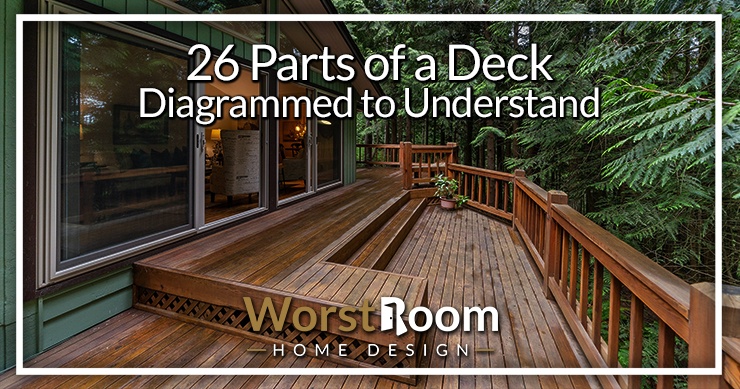
The idea of including a deck on your house sounds interesting, right? Indeed! Decks can add to the overall aesthetics of a home and help you stand out in the neighborhood. To build a deck successfully, you will need knowledge of the parts of a deck and especially honed craftsmanship.
A deck usually consists of a laid-out foundation; on top of it goes the floor, and on the side goes the walls. That's not all; the full deck structure has many other intricate parts that you must know about.
In this article, you will get to know about the parts of a deck through our explanations and decking diagram. We are here to provide information and visual examples to aid your preparations. Without further ado, let's break down the basic anatomy of a deck starting with this diagram of a deck.
Diagram of a Deck
As a quick visual aid and to help you associate deck part names with the actual deck parts, we've prepared this decking diagram for you.
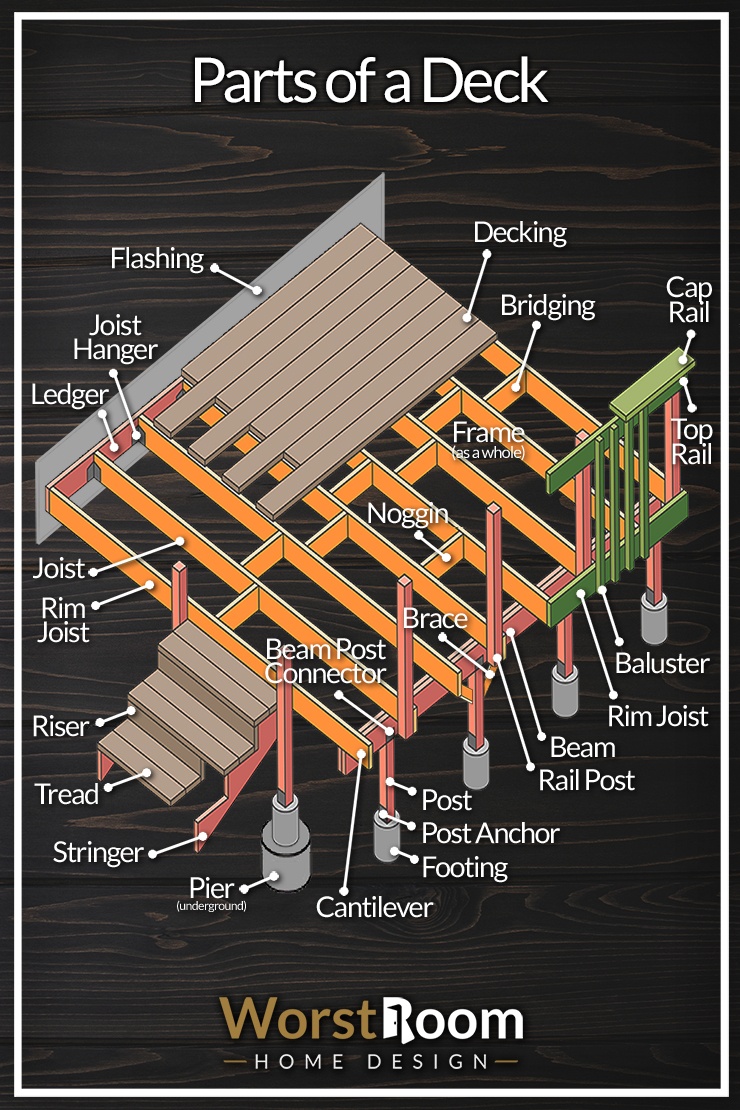
The deck parts diagram above shows all of the components of a deck in one look. Though a deck anatomy can be so complex that we need to look at it from multiple angles, it's quite simple once you see it enough times and begin working with it yourself.
Parts of a Deck Explained
The process of building deck types of patios requires a lot of critical assembly of different parts; only then you can enjoy a solid deck to stand on. You need to start at the bottom and gradually build one part over the other to erect a proper structure. The bottom list shows you the decisive sections of a deck.
Frame
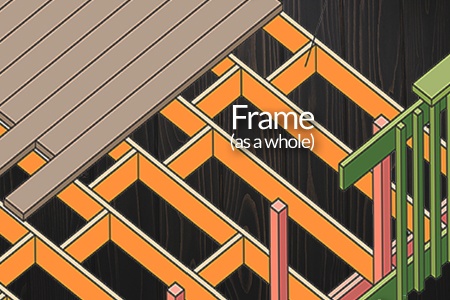
Think of it like a skeleton; just like you have the bone structures to support your body, a deck will need a frame as its support system. A frame will determine the dimension and size of the deck. It will also include pieces like the joists, beams, support posts, footings, etc.
Fascia
The fascia board helps to give the deck a seamless structure. It covers the perimeter of the deck and usually hides the inner components of a frame. In terms of functionality, a fascia is not compulsory; rather, adding it will give your deck some aesthetical touch.
Ledger
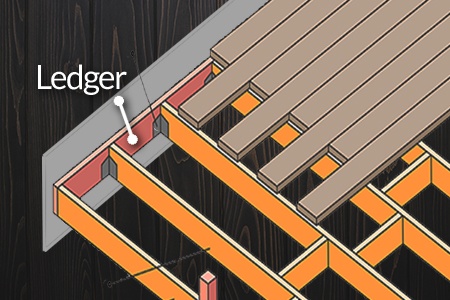
This part especially sets the outer perimeter of a deck. It is considered one of the most important pieces of the frame. It not only sets the width of a deck but also supports other critical parts like the joists. Ledgers are usually attached to the building wall to stabilize the deck.
Flashing
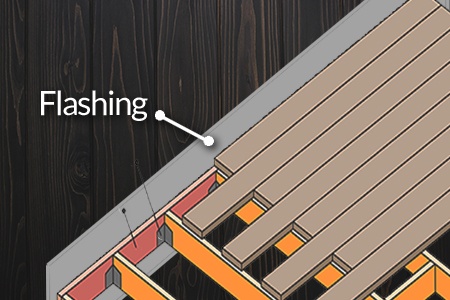
Moisture can be a pain in the neck within a deck structure. This is where flashings come to play. It is an anti-rust and waterproof sheet made of vinyl or metal that covers any exposed area of the deck, such as joints and cracks. Flashings are there to shield the ledger board and wall attached to the frame.
Footings
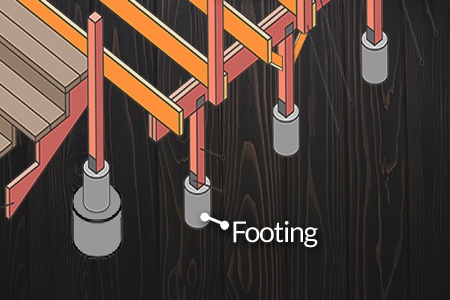
Talk about critical parts; footings are one of them. It is what helps to distribute the weight of the deck evenly so that it doesn't collapse. Footings are placed below the deck and help to elevate the structure from the ground. The number of footings will depend on the size and load capacity of the deck itself.
Joists
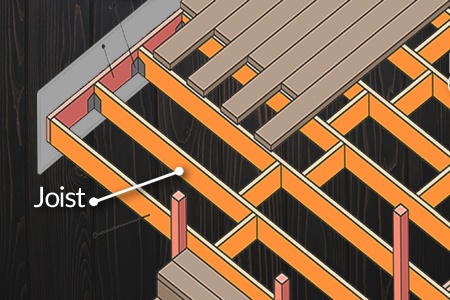
These are parallel lumbers that run through the frame and give the deck its structure. Joists are supported by the rim joists and ledger to create a platform for other components to sit on top of it. Of all the tools you'll use in this process, any types of levels will be critical to have a flat deck surface, as many components of a deck need to be perfectly flat.
Noggins
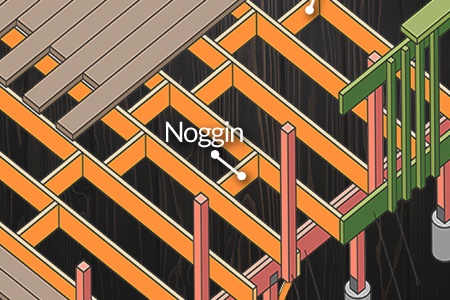
Noggins, or strengthening braces, are short cuts of wood that are wedged between joists and screwed in to keep joists straight and true. They help the joists resist warping, twisting, and cupping much more than leaving them out and hoping the deck boards do that job.
They are staggered during installation mainly so you can reach them to screw them in, but this also redistributes pressure better, too. These are parts of a deck that some people skip out on, to great detriment later.
Rim Joists
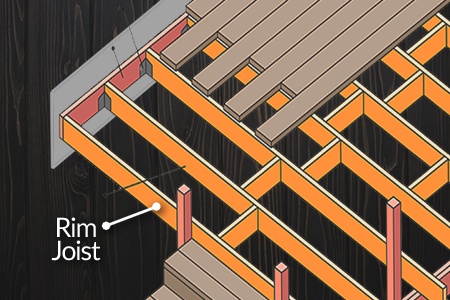
They are perpendicularly attached to the joists and provide the outer edge of the whole structure. Rim joists help maintain the joist spacings and withstand any kind of rotating and twisting. In addition, joists can also offer support to the railings and stairs. The structural integrity of the deck depends on rim joists.
Decking
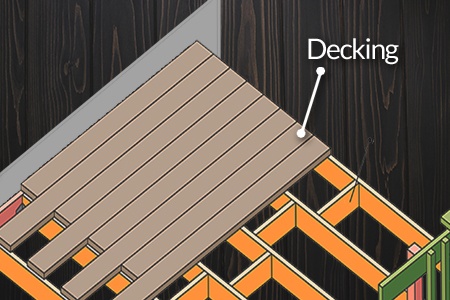
The floor of the deck is what we call decking. Here decking boards are made of either PVC, HDPE, Aluminum, or composite materials, which are used for laying on top of the joists. There are pressure-treated decking boards that can withstand rotting and insects that can add to the longevity of the deck altogether.
Bridging
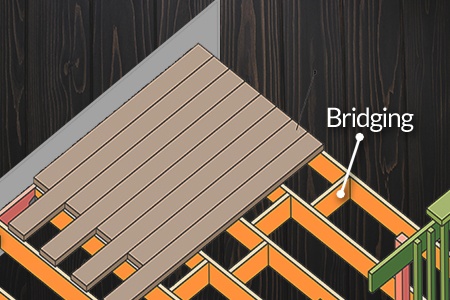
These small wooden pieces are laid in the middle of the joists to give the frame better support and strength. The placement is between, so they don't bend or twist. Adequate bridging can reduce the swaying and lateral movement of the deck, which makes these critical deck parts in terms of structure.
Railing
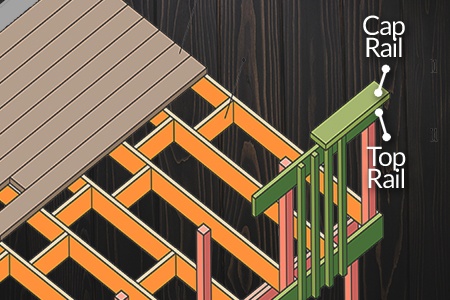
The railings are the additional support system on decks. They are vertically placed on the corners or deck to prevent tipping and falling. Without any types of deck railings, you can fall off the deck and get injured. Railings consist of balusters, rails, and rail posts. Rails can include top rails and cap rails (flat across the top).
Column / Rail Post
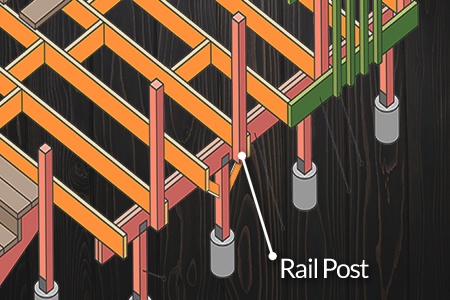
Also known as newel posts, they are made to support the railing and work as baluster frames. Rail posts are vital for holding up the rail and enduring all kinds of applied forces.
Piers
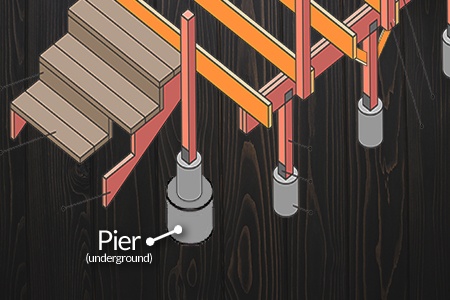
The piers are concrete structures that support the frame's footings. Piers are there to distribute the weight better and offer superior support. There are anchors on top that allow the support post to sit comfortably. These are critical parts of a deck that provide a stable and level foundation.
Beams
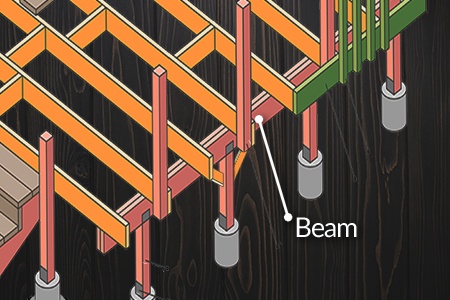
When we talk about the support system for the joists, the beams play a crucial role. Beams are mostly made of lumbar, solid timber, or steel. It is also known to support decking materials. Beams can be created using one plank or by affixing 2 to 4 together.
Stairs
Without the stairs, a deck is incomplete. You don't want to use a deck by hopping on it. Instead, you would want something that allows you to get on and off without any hassle. Stairs are made by lining many riser boards or stringers that ultimately allow you to ascend on and descend the deck. Make sure you know how wide deck stairs should be.
Treads
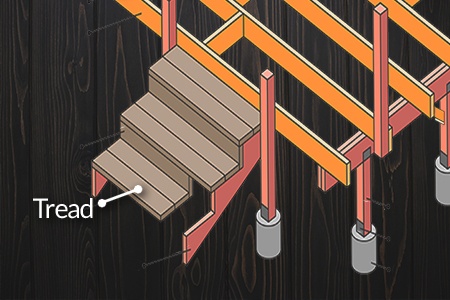
The surface where you step on while climbing a stair is known as the tread. Treads are made in rectangular shape and have a clearance of 10 inches. They are commonly made of wood, concrete, metal, or whatever your deck stairs can take.
Stringers
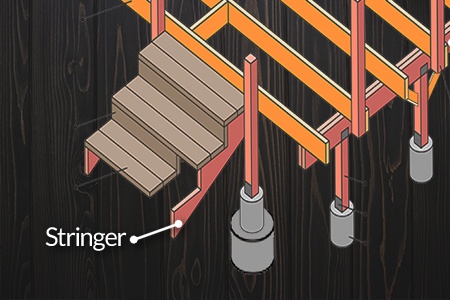
It is a component that adjoins the deck with the ground. Stringers are the connectors between the landing pad and the deck frame. It is made to support the risers and treads that you step on while climbing the stairs. They have a complex shape and must be made to specific measurements to support the person walking on the stairs.
Risers
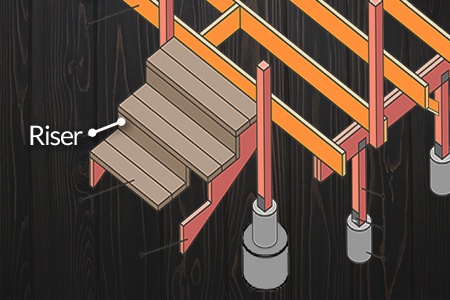
These are components that cover the gap between one thread to the other. The vertical surfaces that you see on stairs are known as risers. It provides the elevation to the steps and is often made of glass, metal, and wood. All decks tend to have an exit path to the ground level, making these critical parts of a deck as they're used frequently and need to be safely constructed.
Baluster / Spindle
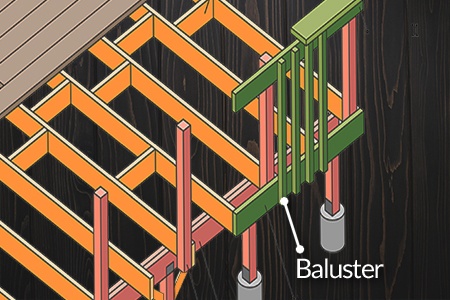
It is a railing component that provides the interior linings of the guardrails. Balusters are jug-shaped decorative pillars without bottom rails that can be mounted on floors, bridges, or decks to create a safety barrier.
Balustrade
The balustrade is what holds the balusters together. Both horizontal and vertical components are used to make the barrier structure. You can simply call it a railing that holds the vertical balusters.
Cantilever
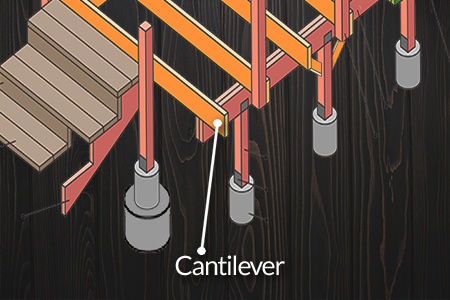
A cantilever produces an overhang structure to the deck's exterior. If you want to extend the deck, cantilevers can be used to provide the extension of the joists surpassing the beams.
Brace
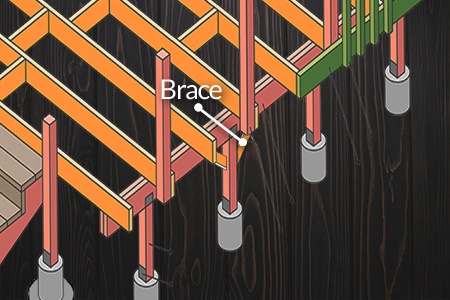
Not compulsory for all decks, but the brace offers better support and protection to the decking. Free-standing decks should be braced for better protection. Bracing improves the overall stiffness of the frame. These are diagonal planks that work as support between beams and posts.
Beam Connectors
Joists that sit on a beam are mostly placed using joist beam connectors. These connectors help to secure the beam and joist in place. Those who miss out on beam connectors are likely to encounter lateral movements of the deck. Joist hangers are another option to secure beams and joists effectively.
Joist Hanger
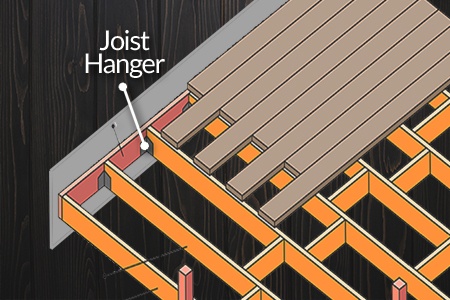
As we said, joist hangers are another form of connector that can attach the joist to the beam or ledger board. When direct nailing is not an option, you can use such hangers to secure the joist conveniently. Decks with angled edges mostly use joist hangers because of their ability to fit in critical spaces.
Beam Post Connectors
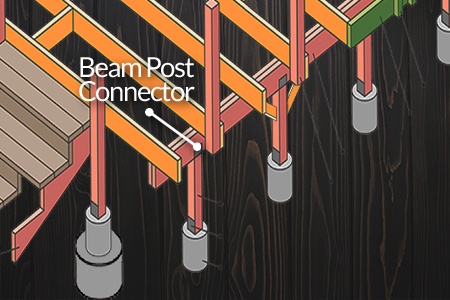
Support posts are prone to lateral movements, and when connected to beams, they are likely to get displaced due to load. Beam post connectors are attached to the notched post that usually supports the beam. Such connectors ensure the frame stays stable no matter the load.
Hidden Fasteners
These are clips made of fiberglass, metal, and other materials that go into the groove of the decking board and tighten the joists. Fasteners help to maintain uniform spacing within the boards. When placed perfectly, these items will adjoin the board to the joist without being visible.
The Parts of a Deck You Can't Build Without
Are you planning to install a deck and uplift the outlook of your house, maybe even add some types of awnings? If you are setting it up yourself, then it's wise to know about the parts of a deck. Without knowing what beams, joists, decking, footing, and other essentials go on to make a deck, you won't be able to build it properly.
Even when hiring a pro, you must be familiar with the terminologies mentioned in this article and diagram of a deck. So when you go to talk to a contractor or supplier for crafting a deck, you will be able to understand each other better when you discuss the deck part names. We believe a deck can simply add extra elegance to your precious home, and that starts with each individual parts of a deck.



